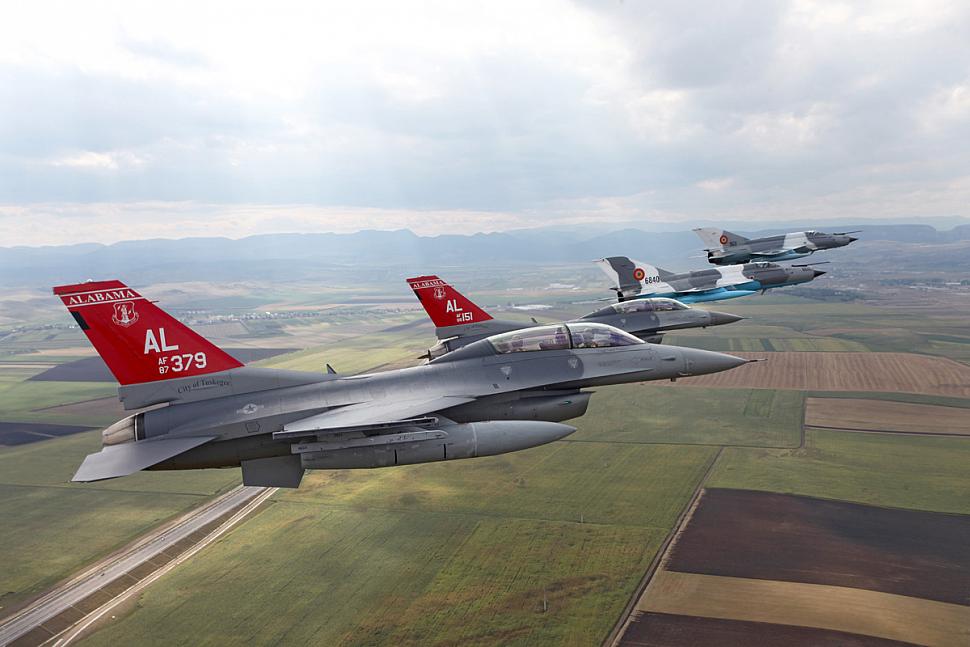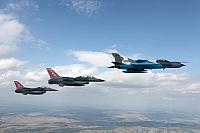Fighter Jet News
F-16 Fighting Falcon News
USAF doc preps Romanian air force pilots for F-16 training
April 23, 2014 (by
SSgt. R.J. Biermann) -
U.S. Air Force Capt. (Dr.) Rocky Jedick, 510th Fighter Squadron flight surgeon, provided a G-force brief to Romanian air force MiG-21 Lancer pilots in preparation for F-16 Fighting Falcon training, at Campia Turzii, Romania, April 11, 2014.
Soon after collaborating with the U.S. forces for bilateral training during Exercise Dacian Viper 2014, Romanian pilots will visit Brooks City-Base, Texas, for centrifuge training to prepare for the transition from the MiG-21 to the F-16. The Romanian government signed a contract with Portugal to acquire 12 F-16s to replace their MiG-21s.
"We're sending our first six pilots to San Antonio to become F-16 pilots," said Romanian air force Col. Nicolae Tanasie, 71st Flying Operations Group deputy commander and exercise director. "They need to be academically prepared to get inside the centrifuge and this training helped prepare them."
A human centrifuge tests a pilot's G-tolerance, or ability to remain conscience under several G's. A G is the measure of gravitational force on an object. Normally, on earth, a person is under one G of force, which is one's body weight.
The pilots, familiar with the MiG-21's ability to withstand up to seven G's, must prepare for the nine-G limit of the F-16.
According to Jedick, the difference between seven and nine G's is substantial. For example, a person who weighs 150 pounds under one G would weigh 1,050 pounds under seven G's and 1,350 pounds at nine G's.
"At nine G's you'll get an idea of what you'll look like in 60 years," Jedick said joking. "The anti-G straining maneuver is a method the pilots use to compensate for excessive G-forces they face.
"We also covered some statistics in terms of the seriousness of excessive G-forces ... so they can understand how serious this can be [when] flying high-performance aircraft," added Jedick.
Another substantial difference between the MiG-21 and F-16 is the seat in the cockpit of an F-16 reclines 30 degrees. According to Jedick, this changes the direction in which the pilot feels the G-force upon their body, which can increase or decrease their tolerance level to G's.
At the invitation of the government of Romania, more than 150 Aviano Airmen are currently serving at the 71st Air Base during the bilateral training exercise. The training exercise aims to enhance interoperability and readiness with the Romania air force through combined air operations.
In October last year, Romania purchased 12 F-16AM/BM Fighting Falcons from Portugal to replace part of its fleet of Russian built MiG-21 Lancer fighter aircraft and thus bring its air force up to NATO standards. The F-16s should be airworthy for at least the next 20 years (4,000-4,500 flight hours).
"We're sending our first six pilots to San Antonio to become F-16 pilots," said Romanian air force Col. Nicolae Tanasie, 71st Flying Operations Group deputy commander and exercise director. "They need to be academically prepared to get inside the centrifuge and this training helped prepare them."
A human centrifuge tests a pilot's G-tolerance, or ability to remain conscience under several G's. A G is the measure of gravitational force on an object. Normally, on earth, a person is under one G of force, which is one's body weight.
The pilots, familiar with the MiG-21's ability to withstand up to seven G's, must prepare for the nine-G limit of the F-16.
According to Jedick, the difference between seven and nine G's is substantial. For example, a person who weighs 150 pounds under one G would weigh 1,050 pounds under seven G's and 1,350 pounds at nine G's.
"At nine G's you'll get an idea of what you'll look like in 60 years," Jedick said joking. "The anti-G straining maneuver is a method the pilots use to compensate for excessive G-forces they face.
"We also covered some statistics in terms of the seriousness of excessive G-forces ... so they can understand how serious this can be [when] flying high-performance aircraft," added Jedick.
Another substantial difference between the MiG-21 and F-16 is the seat in the cockpit of an F-16 reclines 30 degrees. According to Jedick, this changes the direction in which the pilot feels the G-force upon their body, which can increase or decrease their tolerance level to G's.
At the invitation of the government of Romania, more than 150 Aviano Airmen are currently serving at the 71st Air Base during the bilateral training exercise. The training exercise aims to enhance interoperability and readiness with the Romania air force through combined air operations.
In October last year, Romania purchased 12 F-16AM/BM Fighting Falcons from Portugal to replace part of its fleet of Russian built MiG-21 Lancer fighter aircraft and thus bring its air force up to NATO standards. The F-16s should be airworthy for at least the next 20 years (4,000-4,500 flight hours).
Courtesy of 31st Fighter Wing Public Affairs
Additional images:
Related articles:
Forum discussion:
Tags
- DSCA notification of possible sale of F-16s to Romania (2013-11-08)
- Romania buys Portuguese F-16s to replace Lancers (2013-10-14)
- Romania approves purchase of 24 F-16s (2010-03-24)
- Possible F-16 Block 50/52 sale to Romania (2008-05-19)
- F-16 Fighting Falcon news archive
Forum discussion:
- Start a discussion about this article in the F-16.net forum.
Tags


